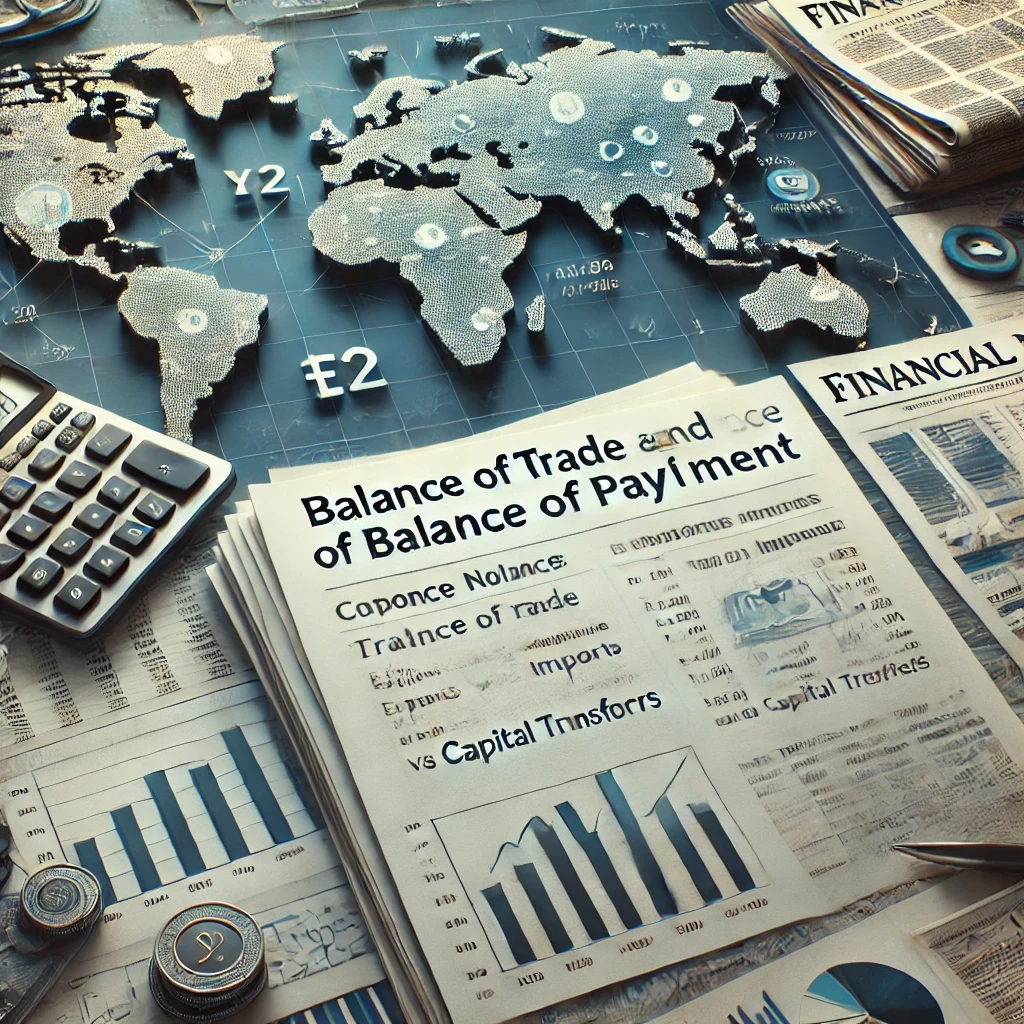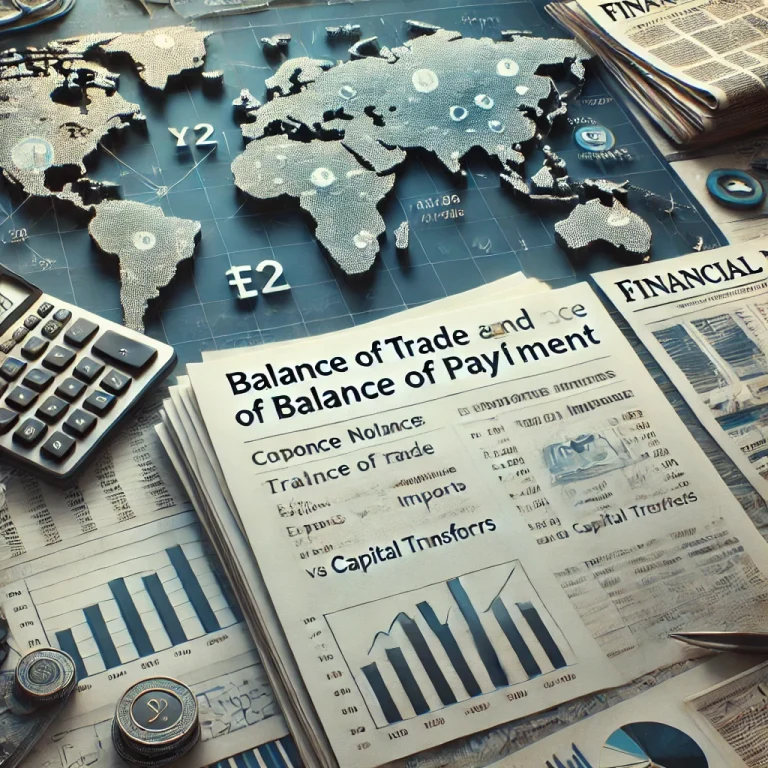The balance of trade and the balance of payments are two highly important indicators of a nation’s economic health. Even though they are interrelated, they reflect different dimensions of international trade and finance. A balance of trade is the net flow of goods between a country and its trading partners. It reflects the status in which a country is a net exporter or importer. A balance of payment is an overarching measure that encompasses not only trade but also financial transactions and investment flows. Understanding these two concepts helps to gauge the global economic standing of a country and its interactions with other economies.
What is Balance of Payment?
A balance of payment is a comprehensive financial statement representing all the economic transactions between the country’s residents and the rest of the world for a definite period. In other words, the balance of payment would include goods and services transactions, financial transfers, investments, and foreign aid. BoP is supposed to give a balance sheet view of the entire economic relationship of a country with the world. It comprises two major accounts: the current account and the capital and financial account.
Key Components of the Balance of Payment
- Current Account:
- Goods and Services: Tracks the export and import of goods (merchandise) and services (tourism, financial services).
- Income: Includes earnings from investments abroad (e.g., dividends, interest).
- Current Transfers: Foreign aid, remittances, and other unilateral transfers.
2. Capital and Financial Account:
- Foreign Direct Investment (FDI): Investments in physical assets like property or businesses.
- Portfolio Investment: Investment in financial assets such as stocks and bonds.
- Foreign Exchange Reserves: Transactions related to a country’s reserves of foreign currencies.
3. Errors and Omissions: An adjustment factor to ensure that the recorded inflows and outflows are balanced.
Significance of BoP
- A BoP surplus is one way of referring to a situation whereby exports exceed imports, the net inflow of funds exceeds outflows of funds, or foreign exchange reserves. In most cases, a surplus points out the power of the economy.
- The deficit in the BoP points out that a country imports more than it exports, financial outflow exceeds financial inflow, or the country is exhausting its foreign reserves. The deficit often points out potential economic trouble.
Example:
If India exports software services worth $100 billion and imports machinery worth $80 billion, with an additional $10 billion in foreign remittances, its current account might show a surplus of $30 billion.
What is Balance of Trade?
It is the net value of a country’s exports relative to imports over a period, and the balance of trade measures the difference between the value of exports and imports of a country’s goods over such a period. It’s an essential pointer for a country’s economic health because it reflects how a nation performs in international trade.
- Trade Surplus: Occurs when the value of exports exceeds the value of imports.
- Trade Deficit: Occurs when the value of imports exceeds the value of exports.
Factors Influencing the Balance of Trade
- Rate of Exchange: the high currency will make imports cheap, making exports expensive. Hence, a trade deficit can occur.
- Tariffs and Trade Policies: measures for the protection of the home industry by setting tariffs have an impact on volume.
- Economic Growth: In the expanding economy, more imports take place. Hence, to avoid a rise in the deficit, exports have to increase pari passu.
Example:
If a country exported electronics worth $500 million but imported oil and machinery worth $600 million, it would have a trade deficit of $100 million.

Difference Between Positive and Negative BoT
- A positive balance of trade or trade surplus can also aid in the consolidation of the domestic economy as more goods are being produced and sold internationally.
- A negative balance of trade or trade deficit may reflect that a country is heavily dependent on foreign goods, which will deplete the foreign exchange reserves.
Difference Between Balance of Payment and Balance of Trade
Although the balance of trade and balance of payment are closely linked, they differ in scope and implications. Here’s a breakdown of their differences:
| Basis | Balance of Trade (BoT) | Balance of Payment (BoP) |
|---|---|---|
| Definition | The difference between a country’s exports and imports of goods. | A comprehensive record of all economic transactions, including goods, services, and capital flows. |
| Scope | Focuses only on tangible goods. | Encompasses goods, services, income, transfers, and capital transactions. |
| Components | Exports and imports of goods. | Current account, capital and financial account, and errors/omissions. |
| Timeframe | Generally measured over a shorter period (monthly, quarterly). | Measured over a longer period (usually annually). |
| Economic Indication | Indicates a surplus or deficit in the trade of goods. | Shows the overall economic health of a country’s foreign transactions. |
| Influence on Exchange Rates | Has a limited direct impact on exchange rates. | Strongly influences the exchange rate as it reflects capital flows. |
Examples:
- If Japan exports cars worth $200 billion and imports oil worth $150 billion, it would have a trade surplus of $50 billion.
- If the United States has a current account deficit but significant inflows in foreign direct investment, its balance of payments might still show an overall surplus.
Conclusion
To put it all together, while the balance of trade is still a part of the balance of payment accounting and highlights the country’s imports and exports in terms of goods alone, BoP accounts for a country’s entire array of economic transactions with the rest of the world, covering services, income, and capital flows. Both measures are important for assessing the economic standing of the country in question, but they do not serve the same analytical purposes. While a trade surplus or deficit may be concerning in the near term, comprehension of the BoP helps to paint a fuller picture of the economic resilience or vulnerability of a nation.
Balance of Trade vs Balance of Payment FAQs
What happens if a country has a balance of payments deficit?
A deficit in the balance of payments means a country is spending more on imports and foreign investments than it earns from exports and investments. It can deplete foreign reserves, potentially leading to currency depreciation.
How does the balance of trade affect the economy?
A positive balance of trade supports domestic production and jobs, while a negative balance of trade might indicate over-reliance on imports, which could affect local industries.
What is the relationship between balance of trade and exchange rates?
Exchange rates can influence the balance of trade. A weaker currency makes exports cheaper and imports more expensive, which can improve the trade balance over time.
Can a country have a balance of trade surplus but a balance of payments deficit?
Yes, this can occur if the capital and financial account records significant outflows, even though the country exports more goods than it imports.
Why is the balance of payments important?
The balance of payments provides a comprehensive view of a country’s financial stability and its ability to meet international obligations, helping guide economic policy decisions.

